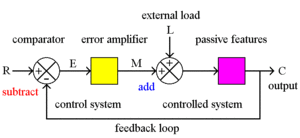Control Systems
Control System is a device, or set of devices to manage, command, direct or regulate the behavior of other device(s) or system(s). Industrial control systems are used in industrial production. There are two common classes of control systems, with many variations and combinations: logic or sequential controls, and feedback or linear controls. There is also fuzzy logic, which attempts to combine some of the design simplicity of logic with the utility of linear control. Some devices or systems are inherently not controllable.
The term control system may be applied to the essentially manual controls that allow an operator, for example, to close and open a hydraulic press, perhaps including logic so that it cannot be moved unless safety guards are in place. An automatic sequential control system may trigger a series of mechanical actuators in the correct sequence to perform a task. For example various electric and pneumatic transducers may fold and glue a cardboard box, fill it with product and then seal it in an automatic packaging machine.
In the case of linear feedback systems, a control loop, including sensors, control algorithms and actuators, is arranged in such a fashion as to try to regulate a variable at a setpoint or reference value. An example of this may increase the fuel supply to a furnace when a measured temperature drops.PID controllers are common and effective in cases such as this. Control systems that include some sensing of the results they are trying to achieve are making use of feedback and so can, to some extent, adapt to varying circumstances. Open-loop control systems do not make use of feedback, and run only in pre-arranged ways.
Classes of control systems
Logic control
Logic control systems for industrial and commercial machinery were historically implemented at mains voltage using interconnected relays, designed using ladder logic. Today, most such systems are constructed with programmable logic controllers or microcontrollers. The notation of ladder logic is still in use as a programming idiom for PLCs. Logic controllers may respond to switches, light sensors, pressure switches, etc., and can cause the machinery to start and stop various operations. Logic systems are used to sequence mechanical operations in many applications. PLC software can be written in many different ways – ladder diagrams, SFC – sequential function charts or in language terms known as statement lists.Examples include elevators, washing machines and other systems with interrelated stop-go operations.Logic systems are quite easy to design, and can handle very complex operations. Some aspects of logic system design make use of Boolean logic.
On–off control
For example, a thermostat is a simple negative-feedback control: when the temperature goes below a set point (SP), the heater is switched on. Another example could be a pressure switch on an air compressor: when the pressure (PV) drops below the threshold (SP), the pump is powered. Refrigerators and vacuum pumps contain similar mechanisms operating in reverse, but still providing negative feedback to correct errors. Simple on–off feedback control systems like these are cheap and effective. In some cases, like the simple compressor example, they may represent a good design choice. In most applications of on–off feedback control, some consideration needs to be given to other costs, such as wear and tear of control valves and maybe other start-up costs when power is reapplied each time the PV drops. Therefore, practical on–off control systems are designed to include hysteresis, usually in the form of a deadband, a region around the setpoint value in which no control action occurs. The width of deadband may be adjustable or programmable.
Linear control
Linear control systems use linear negative feedback to produce a control signal mathematically based on other variables, with a view to maintain the controlled process within an acceptable operating range.The output from a linear control system into the controlled process may be in the form of a directly variable signal, such as a valve that may be 0 or 100% open or anywhere in between. Sometimes this is not feasible and so, after calculating the current required corrective signal, a linear control system may repeatedly switch an actuator, such as a pump, motor or heater, fully on and then fully off again, regulating the duty cycle using pulse-width modulation.
